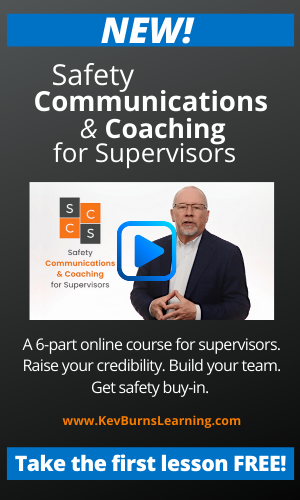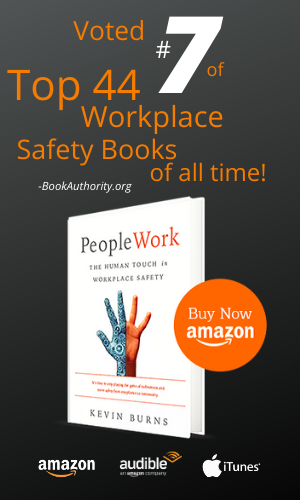Create A Positive, Motivated Team in Safety
How many of your safety meetings are focused on benefits of safety instead of being focused on rules? Let’s look at some of the benefits of safety.
It is interesting to watch professional sports teams head out of the dressing room to conduct their pre-game warm-up. They go through their drills for 20-30 minutes. They get the blood pumping, get their legs warmed up, and get themselves focused on the upcoming game. Then, at the end of warm-up, they head back to the dressing room for their pre-game meeting.
 Just imagine for a moment, a coach during the pre-game meeting called the players attention and said, “listen up guys. This is important. Before we head out for today’s game, we need to review the rules.”
Just imagine for a moment, a coach during the pre-game meeting called the players attention and said, “listen up guys. This is important. Before we head out for today’s game, we need to review the rules.”
Of course, that’s not what happens. At the pre-game meeting, the coach doesn’t focus on rules. The coach takes the time to review the game plan and to get buy-in to the plan from all players. The coach needs the players fully focused on the game and motivated to go out and get a win.
Where is your focus?
How many of your safety meetings are focused on getting buy-in to the game plan today. How many of your safety meetings work on building buy-in and motivation to do their best? Or, is that time being spent on reviewing rules and procedures?
Safety training does not address motivation or how to get buy-in to the safety program. But the Safety Communications & Coaching for Supervisors course does.
Teams that buy-in to the game plan become highly motivated. And professionals shouldn’t need to review the rules either. They should already know the rules.
If you want high levels of buy-in from your people, you are going to need to show them that following your game plan has a benefit to them. That by following the safety program, they get something out of it too. So, what are some of the benefits of safety?
Let’s be clear, not getting hurt is not a benefit.
First, let’s be clear, not getting hurt is not a benefit. Not getting hurt is never a benefit. Because for not getting hurt to be a benefit, that would mean that employees would have to be arriving at work expecting to get hurt. Not many people show up that way. Besides, employees expect that their employer has taken every precaution to provide a safe workplace. So, not getting hurt is not a benefit – it’s an expectation.
 Second, benefits are about positives, not avoiding a negative. Gruesome stories and gut-wrenching images are not positives. That’s focusing on avoiding negatives. The avoidance of a negative doesn’t automatically create a positive. Besides, safety isn’t supposed to make your guts churn. Safety is supposed to make you confident to make good decisions. Feeling confident to make good decisions is a positive benefit.
Second, benefits are about positives, not avoiding a negative. Gruesome stories and gut-wrenching images are not positives. That’s focusing on avoiding negatives. The avoidance of a negative doesn’t automatically create a positive. Besides, safety isn’t supposed to make your guts churn. Safety is supposed to make you confident to make good decisions. Feeling confident to make good decisions is a positive benefit.
What are some of the other positives that your team does for each other? What are the benefits of working together, learning from and caring for your fellow team members?
What workplace do your people deserve?
In a workplace where employees feel valued, cared for, respected and that they can trust that their fellow team members will look out for them, there is great benefit in that. Peace of mind at work is a tremendous benefit. Knowing you can count on your fellow employees is a benefit. Your family worries less when they know your teammates have your back and will actively look out for you.
Any time you can eliminate worry, fear and stress, that’s a tremendous benefit. When complacency is no longer a concern, that’s a benefit. When there is trust and respect among all members of the team, there is benefit in that. When the team prides itself on doing excellent work and not allowing each other to take shortcuts, there is benefit in that.
The benefits of safety aren’t necessarily about anything you avoid, but about how you feel about the work you do, the way you do it, and the people you do it with. Everyone deserves a positive workplace that cares about their people. The whole team’s commitment to safety can deliver those benefits.
Ask your team to identify the benefits of working safely.
Here’s the exercise that gets you started on identifying benefits for your own team. Bring your people together in a roundtable discussion and ask them to identify what they perceive as the benefits of working safely, eliminating shortcuts and complacency. Write down their answers on an easel or whiteboard. Don’t be satisfied with just the few first answers. Ask them to really think about what benefit they get from working with a team of caring individuals. Then, when you have prepared an exhaustive list, ask for their commitment to each other that they begin to subscribe to a higher standard and respect for each other.
There is great benefit in that.
-- Take the FREE preview lesson of Kevin's course Safety Communications & Coaching for Supervisors. 40-minutes of video instruction, summary download PDFs and a companion audio MP3 version to take with you on the go. SCCS is an online course to help energize safety, build teamwork, and get employee buy-in.
Take the FREE preview lesson of Kevin's course Safety Communications & Coaching for Supervisors. 40-minutes of video instruction, summary download PDFs and a companion audio MP3 version to take with you on the go. SCCS is an online course to help energize safety, build teamwork, and get employee buy-in.
Kevin Burns, consultant/author, works with smart, caring companies to energize safety culture, build teamwork, and get employee buy-in. KevBurns Learning is committed to to helping companies improve safety by improving people, through creative learning materials, virtual strategy sessions, safety meeting presentations, and team coaching programs.
In 2020, BookAuthority.org named PeopleWork #7 of The Top 44 Workplace Safety Books of All Time. Buy yourself a copy of PeopleWork: The Human Touch in Workplace Safety and give another as a gift to a colleague.
Subscribe to Kevin's YouTube channel.
Subscribe to Kevin’s Blog.


